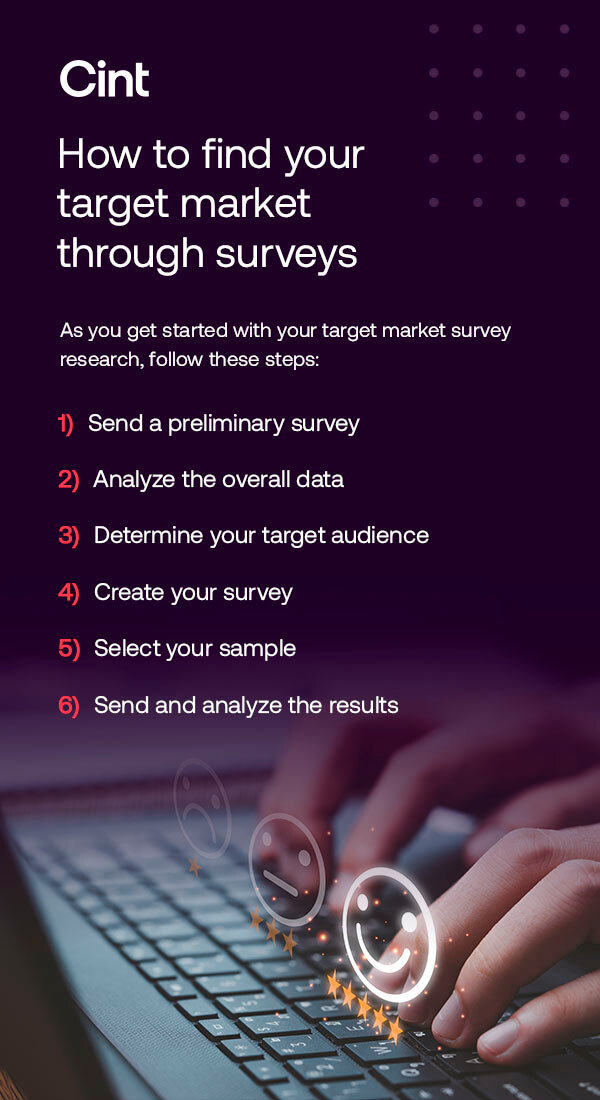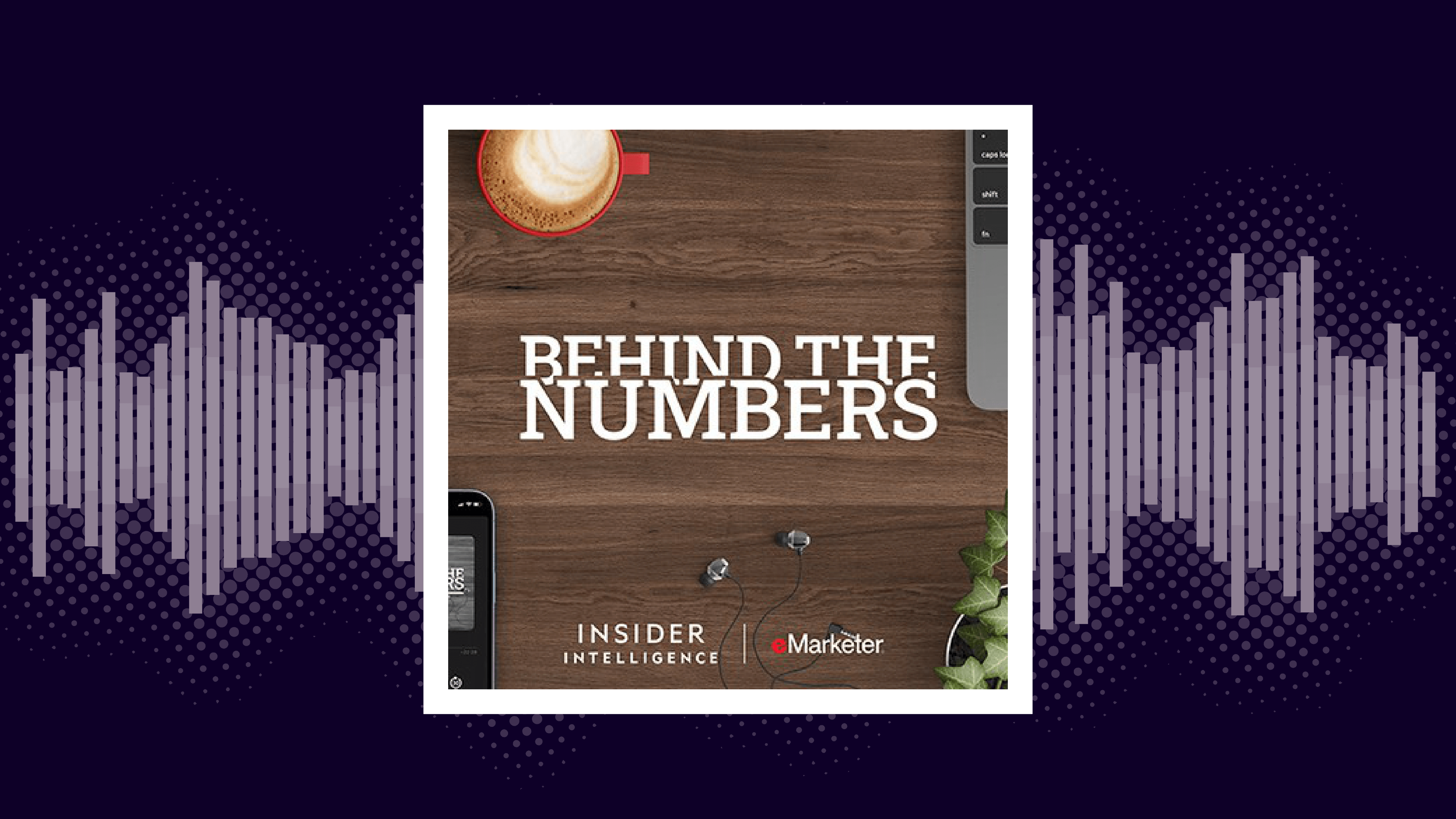Contents
- What is a target market?
- Importance of defining a target market
- How to define a target market
- How to find your target market through surveys
- Questions to ask to confirm target market
- Find your target sample with Cint
- Understanding your overall market
- Identifying customer segments
- Selecting segmentation characteristics
- Send a preliminary survey
- Analyze the overall data
- Determine your target market
- Create your survey
- Select your sample
- Send and analyze the results
- Screening questions
- Segment qualifiers
Categories
 Because marketing is customer-centric and values-based, all marketers must have a thorough understanding of their audiences to succeed. To achieve this insight, you’ll need to identify your target audience in the first place. It’s best to learn about your respondents in their own words, so you should use a combination of online surveys and target market research to determine your ideal customers.
Are you ready to get started? Continue reading to learn how to identify your target market through surveys.
Because marketing is customer-centric and values-based, all marketers must have a thorough understanding of their audiences to succeed. To achieve this insight, you’ll need to identify your target audience in the first place. It’s best to learn about your respondents in their own words, so you should use a combination of online surveys and target market research to determine your ideal customers.
Are you ready to get started? Continue reading to learn how to identify your target market through surveys.
What is a target market?
A target market is a well-defined group of people to whom you market your products or services. More than that, the members of your target market should be interested in and value your offering. Consumers have a diverse range of lifestyles, values, wants and needs. Not everyone will face the same problems, and a product that one person is ecstatic about might not even turn another person’s head. For instance, a woman in her 50s likely has different clothing preferences than a woman in her 20s. You’ll further break down your target market into segments. Target segments are distinct, homogenous groups within your market. A homogenous segment should align on a predefined characteristic that’s important to your business. For example, if your target market is a group of nurses, you might distinguish between nurses who are parents and those without kids. The working parent’s segment will be wildly diverse, but they’ll all share one unifying trait — parenthood. You can then personalize your marketing messages to each group. Understanding this distinction will help you develop products, marketing messages, distribution strategies and pricing structures that suit your target market and each segment.
Importance of defining a target market
Your target market allows you to differentiate your marketing strategies across customer segments. Defining your target market will benefit you by:- Creating competitive advantage: In today’s marketplace, consumers can easily compare products with a simple online search. Your customers will find the products that best suit them, which means a company with a generalized marketing strategy loses a critical competitive advantage.
- Engaging prospects: HubSpot found that 40% of marketers and salespeople find it difficult to solicit responses. Consider using a differentiated marketing strategy with products and messaging designed for your audience segments to engage more prospects. Consumers are far more likely to care about an offering if they can see how it fits into their lives. In fact, audience targeting is one of the best tactics to generate more demand from ads.
- Increasing brand advocates: Attracting the right customers will also empower you to delight your audience. If the people who buy your products or services align with what you have to offer, you’ve set yourself up for success. You can provide your customers with an offering they love and want to recommend to their friends. Brand advocacy from your current customers generates 68% of new customers on average.
- Budgeting your marketing spend: Understanding your target market enables you to allocate marketing funds strategically. Every ad you place, content strategy you develop and distribution channel you add will center your target market’s needs.
How to define a target market
To define a target audience, you first need to understand your overall market, then drill down to the individual customer segments you want to target.Understanding your overall market
To know your overall market, begin with your business plan, considering the following questions:- What products or services are you selling?
- Which industry do you operate in?
- Who are the customers in that sector?
- Do they all share a particular set of problems, demographic characteristics or professions?
- How large is the market, and what is its projected growth in the coming years?

Identifying customer segments
Once you understand your industry and the market at large, you’ll need to break this group into homogenous segments. If you’ve conducted strong research in the previous stage, you can use those insights to spot patterns. Did your initial market research reveal differences across age categories, gender or location? Send out another survey to confirm these customer segments and dive deeper into their values, needs, lifestyles and pain points. With this data in hand, conduct a target market survey analysis to form a complete picture of each segment and determine which groups will be your most lucrative investments.Selecting segmentation characteristics
As you conduct your target market analysis, you’ll need to know which characteristics make good segmentation bases. Each attribute carries distinct advantages and suits different business needs. A few of the most common segmentation characteristics are:- Demographics: The most straightforward to identify demographic characteristics includes information like gender, age, and location.
- Shopping behaviors: Does your target market shop online or in-store? Are they methodical buyers, or do they trend toward impulse purchases? How price-conscious are they?
- Lifestyle: You might segment based on your audience’s hobbies or which devices they use. Are they planners or improvisers? Do they work from home, or are they in the office? Do they travel often? These questions are just a few examples of ways you can divide your audience based on any lifestyle characteristics relevant to your company.
- Psychographics: What are your target customers’ values? Do certain segments share opinions about a relevant topic? For example, you might identify an environmentally conscious segment or a group that values learning.
- B2B characteristics: If you’re a B2B company, you might segment your audience based on their industry, revenue or number of employees.
- Pain points: Sometimes, your products or services answer multiple problems. For example, exercise equipment could appeal to health-conscious consumers and people who simply love exercising and acknowledge the health benefits as a nice side effect.

How to find your target market through surveys
As we’ve hinted throughout this article, surveys are one of the best ways to gain deeper insight from your customers in their own words. With surveys, you can learn about your target market’s shopping habits, values, lifestyles and pain points as your customers see them. Many online survey tools also allow you to apply logic-based progression to give each potential segment different questions — all in the same survey. As you get started with your target market survey research, follow these steps:-
Send a preliminary survey
-
Analyze the overall data
-
Determine your target market
-
Create your survey
-
Select your sample
-
Send and analyze the results
Questions to ask to confirm target market
While many online survey tools allow you to define your target characteristics, it’s crucial to use screening questions and qualifiers. These are necessary steps for all surveys, allowing you to confirm your target audience.Screening questions
The first questions your respondents see are your screeners. In your preliminary survey, you determined who your target market is. Use that information to form questions that filter out any non-target participants. You might base your screening questions on demographic variables such as age, gender, marital status and income. You could also include behavioral factors. In our bookstore example, you only want to target people who read a certain number of books a year. Turn this information into a screener to deter irrelevant responses that might muddy your data. B2B companies will likely have different screening questions than B2C companies. For example, you might only want to target employees with buying power. You could achieve this by asking a preliminary question about the respondent’s job position. Perhaps you’re targeting companies with a substantial budget to potentially spend on your products. For example, if you’re an advertising agency, you might ask how much the company spends annually on ads. Then, you can filter out the participants who answer below your target number. Use disqualification logic in your survey creation tool to send anyone who gives a non-target response directly to a “thank you” page.Segment qualifiers
In addition to screeners, you can use questions to differentiate between each segment, as mentioned above. These segment qualifiers won’t affect who can complete your survey, but they might impact the questions each respondent sees. If you don’t have specific sets of questions for each segment or need your entire target market to answer certain questions, filter the resulting data based on these qualifiers. For example, the advertising agency might want to gather information on universities, clothing retailers and restaurants. They can ask questions about the respondents’ industries to glean insights specific to each segment. If the agency has unique questions that only apply to universities, they could use question logic to send university respondents to that page. Otherwise, information filters can reveal how the universities’ answers differed from the restaurants’ and retailers’ responses in the analysis stage.



































































































